
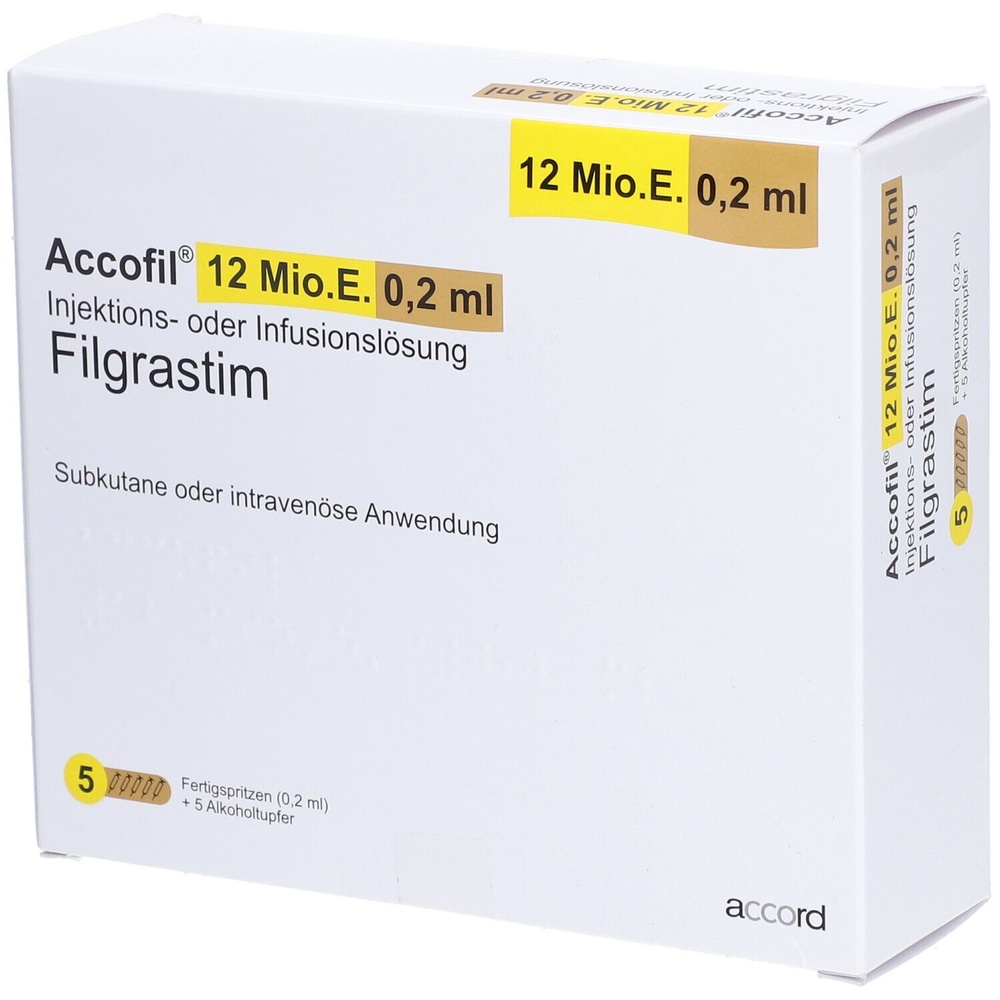
АКОФІЛ 12 МО/0,2 мл Розчин для ін'єкцій та інфузій у попередньо заповненому шприці


Інструкція із застосування АКОФІЛ 12 МО/0,2 мл Розчин для ін'єкцій та інфузій у попередньо заповненому шприці
Введення
ОСНОВНІ ВІДОМОСТІ: ІНФОРМАЦІЯ ДЛЯ ПОТРІБНИКА
Accofil 12 МО/0,2 мл (0,6 мг/мл) розчин для ін'єкції та інфузії в попередньо наповненому шприці
філграстим
Перш ніж почати використовувати цей лікарський засіб, уважно прочитайте весь листок інструкції, оскільки він містить важливу інформацію для вас.
- Збережіть цей листок інструкції, оскільки вам може знадобитися знову його прочитати.
- Якщо у вас виникли питання, проконсультуйтеся з вашим лікарем, медсестрою чи фармацевтом.
- Цей лікарський засіб призначений тільки вам, і його не слід давати іншим людям, навіть якщо вони мають такі самі симптоми, як і ви, оскільки це може їм зашкодити.
- Якщо ви відчуваєте побічні ефекти, проконсультуйтеся з вашим лікарем, фармацевтом чи медсестрою, навіть якщо це побічні ефекти, які не вказані в цьому листку інструкції. Див. розділ 4.
Зміст листка інструкції
- Що таке Accofil і для чого він використовується
- Що потрібно знати перед початком використання Accofil
- Як використовувати Accofil
- Можливі побічні ефекти
- Збереження Accofil
- Зміст упаковки та додаткова інформація
1. Що таке Accofil і для чого він використовується
Що таке Accofil
Accofil є фактором росту лейкоцитів (фактором стимуляції колоній гранулоцитів) і належить до групи лікарських засобів, званих цитокінами. Фактори росту - це білки, які природно виробляються в організмі, але також можуть бути створені за допомогою біотехнології для використання як лікарські засоби. Accofil діє шляхом стимуляції кісткового мозку до виробництва更多 лейкоцитів.
Зниження кількості лейкоцитів (нейтропенія) може виникнути з різних причин і робить ваш організм менш здатним боротися з інфекціями. Accofil стимулює кістковий мозок до швидкого виробництва нових лейкоцитів.
Accofil можна використовувати:
- для збільшення кількості лейкоцитів після лікування хіміотерапією, щоб допомогти запобігти інфекціям;
- для збільшення кількості лейкоцитів після трансплантації кісткового мозку, щоб допомогти запобігти інфекціям;
- до початку хіміотерапії високої інтенсивності, щоб кістковий мозок виробляв більше клітин-попередників, які можна зібрати та повернути після лікування. Ці клітини можуть бути взяті з вас або від донора. Клітини-попередники повернуться потім до кісткового мозку та вироблять лейкоцити;
- для збільшення кількості лейкоцитів, якщо ви страждаєте на хронічну важку нейтропенію, щоб допомогти запобігти інфекціям;
- у пацієнтів з прогресивною інфекцією ВІЛ, щоб допомогти зменшити ризик інфекцій.
2. Що потрібно знати перед початком використання Accofil
Не використовувати Accofil
- Якщо ви алергічні на філграстим або на будь-який інший компонент цього лікарського засобу (перелічені в розділі 6).
Попередження та обережність
Проконсультуйтеся з вашим лікарем, фармацевтом чи медсестрою перед початком використання Accofil:
Перш ніж почати лікування, повідомте вашому лікареві, якщо у вас:
- анемія дрепаноцітична, Accofil може викликати дрепаноцітичну кризу.
- остеопороз (хвороба кісток)
Негайно повідомте вашому лікареві під час лікування Accofil, якщо:
- у вас болить у верхній лівій частині живота, болить під ребрами зліва або в лівому плечі (це можуть бути симптоми збільшення селезінки (спленомегалія) або можливого розриву селезінки).
- ви помітили незвичайне кровотечу або синяки (це можуть бути симптоми меншої кількості тромбоцитів у крові (тромбоцитопенія) з зменшеною здатністю згортання крові).
- у вас раптово з'явилися ознаки алергії, такі як висип, свербіж або кропив'янка на шкірі, набухання обличчя, губ, язика або інших частин тіла, відсутність дихання, свистячий звук при диханні або проблеми з диханням, оскільки це можуть бути ознаки важкої алергічної реакції (гіперчутливості).
- ви відчуваєте набухання обличчя або щиколоток, кров у сечі або сеча коричневого кольору чи помітили, що виходить менше сечі, ніж зазвичай (гломерулонефрит).
- Якщо у вас є симптоми запалення аорти (большої кровної судини, яка транспортує кров від серця до решти тіла), це рідко спостерігається у пацієнтів з раком і у здорових донорів. Симптоми можуть включати лихоманку, біль у животі, загальне нездоров'я, біль у спині та підвищені показники запалення. Повідомте вашому лікареві, якщо ви маєте ці симптоми.
Втрата реакції на філграстим
Якщо ви відчуваєте втрату реакції або відмову від підтримки реакції при лікуванні філграстимом, ваш лікар буде досліджувати причини, включаючи те, чи розвинулися у вас антитіла, які нейтралізують дію філграстиму.
Ваш лікар може бажати спостерігати за вами уважно, див. розділ 4 листка інструкції.
Якщо ви пацієнт з хронічною важкою нейтропенією, ви можете мати ризик розвитку раку крові (лейкемії, мієлодиспластичного синдрому (МДС). Ви повинні обговорити з вашим лікарем ризики розвитку раку крові та які аналізи потрібно проводити. Якщо ви розвинуєте або будете мати ризик розвитку раку крові, не слід використовувати Accofil, якщо тільки ваш лікар не призначить інакше.
Якщо ви донор клітин-попередників, вам повинно бути від 16 до 60 років.
Будьте особливо обережні з іншими продуктами, які стимулюють лейкоцити
Accofil належить до групи лікарських засобів, які стимулюють вироблення лейкоцитів. Ваш лікар повинен завжди реєструвати точний продукт, який ви використовуєте.
Інші лікарські засоби та Accofil
Повідомте вашому лікареві або фармацевту, якщо ви приймаєте, нещодавно приймали або можете приймати інші лікарські засоби.
Вагітність та лактація
Accofil не досліджувався у вагітних жінок чи під час лактації.
Accofil не рекомендується під час вагітності.
Важливо повідомити вашому лікареві, якщо:
- ви вагітні або перебуваєте у період лактації;
- ви вважаєте, що можете бути вагітні; або
- ви плануєте завагітніти.
Якщо ви завагітнієте під час лікування Accofil, повідомте вашому лікареві.
Якщо тільки ваш лікар не призначить інакше, ви повинні перервати лактацію, якщо використовуєте Accofil.
Водіння транспортних засобів та використання машин
Accofil може трохи впливати на вашу здатність водити транспортні засоби або використовувати машини. Цей лікарський засіб може викликати головокружіння. Рекомендується чекати та спостерігати, як ви відчуваєте себе після прийому Accofil, перш ніж водити транспортні засоби або використовувати машини.
Accofil містить натрій
Цей лікарський засіб містить менше 1 ммоль натрію (23 мг) на дозу; це означає, що він практично не містить натрію.
Accofil містить сорбітол
Цей лікарський засіб містить 50 мг сорбітолу в кожному мл. Сорбітол є джерелом фруктози. Якщо ви (або ваш дитина) страждаєте на спадкову непереносимість фруктози (СНФ), рідкісне генетичне захворювання, не слід приймати цей лікарський засіб. Пацієнти з СНФ не можуть розщеплювати фруктозу, що може призвести до важких побічних ефектів.
Проконсультуйтеся з вашим лікарем перед прийомом цього лікарського засобу, якщо ви (або ваш дитина) страждаєте на СНФ або якщо ваш дитина не може приймати харчові продукти чи напої з цукром, оскільки це може викликати головокружіння, нудоту, блювоту або неприємні ефекти, такі як набухання, болі в животі або діарея.
Алергія на натуральний каучук (латекс). Покриття голки попередньо наповненого шприця містить сухий натуральний каучук (походження від латексу), який може викликати важку алергічну реакцію.
3. Як використовувати Accofil
Слідуйте точно інструкціям з адміністрації цього лікарського засобу, вказаним вашим лікарем. У разі сумнівів проконсультуйтеся з вашим лікарем, медсестрою чи фармацевтом.
Як вводиться Accofil і яку кількість слід використовувати?
Accofil зазвичай вводиться як щоденна ін'єкція в тканину, розташовану прямо під шкірою (це називається підшкірною ін'єкцією). Також його можна вводити як щоденна повільна інфузія в вену (це називається внутрішньовенною інфузією). Звичайна доза варіюється залежно від вашого захворювання та ваги. Ваш лікар призначить кількість Accofil, яку ви повинні використовувати.
Пацієнти, які пройшли трансплантацію кісткового мозку після хіміотерапії:
Зазвичай ви отримуєте першу дозу Accofil не менше 24 годин після хіміотерапії та не менше 24 годин після трансплантації кісткового мозку.
Ви чи особи, які за вас доглядають, можете навчитися вводити підшкірні ін'єкції, щоб продовжити лікування вдома. Однак не слід намагатися зробити це, якщо тільки ваш лікар не навчив вас раніше.
Як довго вам потрібно буде приймати Accofil?
Вам потрібно буде приймати Accofil, поки кількість лейкоцитів у вашому організмі не стане нормальною. Вам будуть проводити періодичні аналізи крові для контролю кількості лейкоцитів у вашому організмі. Ваш лікар призначить, як довго вам потрібно буде приймати Accofil.
Використання у дітей та підлітків
Accofil використовується для лікування дітей та підлітків, які приймають хіміотерапію або страждають на важку нейтропенію. Дозування у дітей та підлітків, які приймають хіміотерапію, таке саме, як і для дорослих.
Інформація для самостійного введення
Цей розділ містить інформацію про те, як самостійно вводити ін'єкцію Accofil. важливо не намагатися вводити ін'єкцію без отримання необхідної підготовки від вашого лікаря чи медсестри. Якщо ви не впевнені, чи можете самостійно вводити ін'єкцію, чи маєте будь-які сумніви, проконсультуйтеся з вашим лікарем чи медсестрою.
Як мені вводити Accofil?
Вам потрібно буде вводити ін'єкцію в тканину прямо під шкірою. Це називається підшкірною ін'єкцією. Ін'єкцію потрібно вводити щодня приблизно о同じ час.
Необхідне обладнання
Для введення підшкірної ін'єкції вам потрібно буде:
- попередньо наповнений шприц з Accofil та
- газа, змочена спиртом або подібна.
Що мені потрібно зробити перед введенням підшкірної ін'єкції Accofil?
Переконайтеся, що покриття голки залишається на шприці до моменту, коли ви будете готові зробити ін'єкцію.
- Видаліть попередньо наповнений шприц з Accofil з холодильника.
- Перевірте термін придатності, вказаний на шприці (КІД). Не використовувати, якщо термін придатності закінчився або якщо шприц був поза холодильником більше 15 днів або якщо він просрочений іншим чином.
- Перевірте вигляд Accofil. Він повинен бути прозорою та безбарвною рідиною. Якщо є частинки всередині, не слід використовувати його.
- Для більш комфортної ін'єкції залиште шприц при кімнатній температурі на 30 хвилин або тримайте шприц у руках кілька хвилин. Не нагрівайте Accofil іншим способом (наприклад, не нагрівайте його в мікрохвильовій печі чи в гарячій воді)
- Ви мийте руки ретельно.
- Знайдіть зручне та добре освітлене місце та розмістіть все необхідне в зручному місці (попередньо наповнений шприц з Accofil та газу, змочену спиртом).
Як мені потрібно підготувати ін'єкцію Accofil?
Перш ніж зробити ін'єкцію, потрібно:
Ніколи не використовувати попередньо наповнений шприц, який був упущений на тверду поверхню.
Крок 1: Перевірити цілісність системи
Ви повинні переконатися, що система цілісна та не пошкоджена. Не використовувати продукт, якщо він пошкоджений (якщо шприц або захисник голки пошкоджені) або якщо є вільні компоненти, або якщо захисник голки знаходиться в відкритому положенні, як показано на Фігурі 9, оскільки це означає, що система вже була активована. Зазвичай продукт не слід використовувати, якщо він не відповідає Фігурі 1. У цьому випадку продукт потрібно викинути у контейнер для видалення небезпечних біологічних відходів.
Фігурі 1
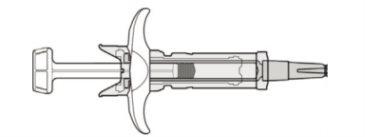
Крок 2: Видалити захисник голки
- Видаліть захисник голки, як показано на Фігурі 2. Утримуйте захисник голки однією рукою, з голкою, спрямованою в бік, протилежний вам, та не торкайтеся поршня шприця. Видаліть захисник голки іншою рукою. Після цього викиньте захисник голки у контейнер для видалення небезпечних біологічних відходів.
- Ви можете помітити невелику повітряну бульку в попередньо наповненому шприці. Не потрібно видаляти повітряну бульку перед ін'єкцією. Ін'єкція розчину з повітряною булькою безпечна.
- Шприц може містити більше рідини, ніж вам потрібно. Використовуйте шкалу шприця, як показано нижче, щоб встановити правильну дозу Accofil, яку ваш лікар призначив. Видаліть зайву рідину, натиснувши на поршень до позначки (мл) на шприці, яка відповідає призначеній дозі.
- Перевірте ще раз, чи правильна доза Accofil.
- Тепер ви можете використовувати попередньо наповнений шприц.
Фігурі 2

Де мені потрібно зробити ін'єкцію?
Найбільш підходящими місцями для ін'єкції є:
- верхня частина стегон, і
- живіт, крім області навколо пупка (див. Фігурі 3).
Фігурі 3
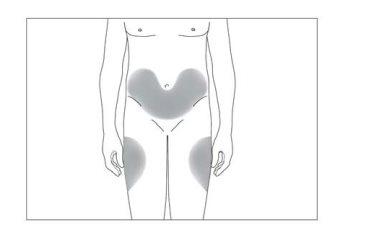
Якщо хтось інший робить ін'єкцію, також можна використовувати задню частину передпліччя (див. Фігурі 4).
Фігурі 4
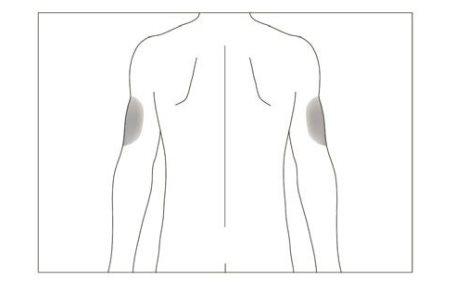
Для уникнення ризику болю в конкретному місці краще змінювати місце ін'єкції щодня.
Крок 3: Вставити голку
- Злегка стисніть шкіру в місці ін'єкції;
- Вставьте голку в місце ін'єкції без торкання поршня шприця (під кутом 45-90 градусів). (Див. Фігурі 6 і 7)
Як мені потрібно зробити ін'єкцію?
Дезінфікуйте місце ін'єкції, використовуючи газу, змочену спиртом, та стисніть шкіру між великим та вказівним пальцями, не стискаючи (див. Фігурі 5).
Фігурі 5
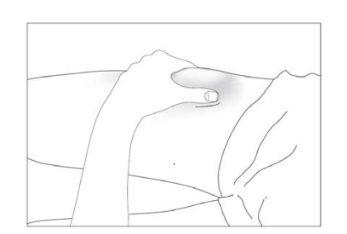
Попередньо наповнений шприц без захисника голки
- Вставьте голку повністю в шкіру, як показав ваш лікар чи медсестра (див. Фігурі 6).
- Легко потягніть за поршень, щоб перевірити, чи не було влучено в кровоносну судину. Якщо ви бачите кров у шприці, вийміть голку та знову вставьте її в інше місце.
- Тримаючи шкіру стиснутою, повільно натисніть на поршень, доки не буде введена вся доза, доки поршень не зможе рухатися далі. Не зупиняйте натиск на поршень!
- Введіть тільки призначену вашим лікарем дозу.
- Після ін'єкції рідини вийміть голку, тримаючи натиск на поршень, та потім звільніть шкіру.
- Помістіть шприц у спеціальний контейнер для видалення. Кожен шприц призначений для однієї ін'єкції.
Фігурі 6
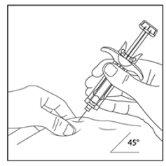
Попередньо наповнений шприц з захисником голки
- Вставьте голку повністю в шкіру, як показав ваш лікар чи медсестра.
- Легко потягніть за поршень, щоб перевірити, чи не було влучено в кровоносну судину. Якщо ви бачите кров у шприці, вийміть голку та знову вставьте її в інше місце.
- Введіть тільки призначену вашим лікарем дозу, слідуючи інструкціям нижче.
Фігурі 7
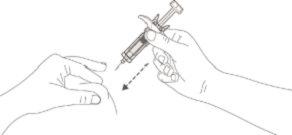
Крок 4: Ін'єкція
Помістіть великий палець на кінці поршня. Натисніть на поршень та сильно натисніть, щоб забезпечити повне видалення рідини з шприця (див. Фігурі 8). Тримайте шкіру також сильно, доки не буде завершено введення.
Фігурі 8
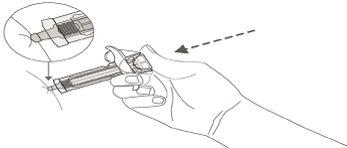
Крок 5: Захист від випадкових колючок
Система безпеки активується, коли поршень натискається до кінця:
- Не рухаючи шприц, повільно підніміть великий палець з кінця поршня;
- Поршень підніметься з пальцем, та пружина відтягне голку з місця ін'єкції всередину захисника голки (див. Фігурі 9).
Фігурі 9
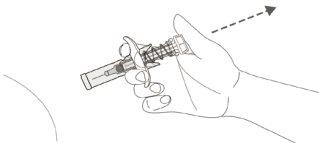
Пам'ятайте
Якщо у вас є будь-які сумніви, просіть допомоги та порад у вашого лікаря чи медсестри.
Як викинути використані шприци
- Захисник голки запобігає колючкам голкою після використання, та тому не потрібні спеціальні заходи для видалення. Викиньте шприц так, як вказав ваш лікар, медсестра чи фармацевт.
Якщо ви використали більше Accofil, ніж потрібно
Не збільшуйте дозу, призначену вашим лікарем. Якщо ви вважаєте, що ввели більше, ніж потрібно, негайно зв'яжіться з вашим лікарем.
Якщо ви забули використати Accofil
Якщо ви пропустили ін'єкцію або ввели менше, ніж потрібно, зв'яжіться з вашим лікарем, щоб обговорити, коли вам потрібно зробити наступну ін'єкцію якнайшвидше. Не приймайте подвійну дозу, щоб компенсувати пропущену ін'єкцію.
Якщо у вас є будь-які інші питання щодо використання цього лікарського засобу, просіть поради у вашого лікаря, медсестри чи фармацевта.
4. Можливі побічні ефекти
Як і всі лікарські засоби, цей лікарський засіб може викликати побічні ефекти, хоча не всі люди їх відчувають.
Повідомте своєму лікареві негайно під час лікування:
- Якщо ви відчуваєте алергічну реакцію з слабкістю, зниженням артеріального тиску, труднощами з диханням, набряком на обличчі (анafilaxia), висипом на шкірі, висипом (судинним висипом), набряком на обличчі, губах, роті, язиці або горлі (ангіоедем) і відсутністю дихання (диспноею).
- Якщо ви відчуваєте ушкодження нирок (гломерулонефрит). У пацієнтів, які приймали Accofil, спостерігались ушкодження нирок. Повідомте своєму лікареві негайно, якщо ви відчуваєте набряк на обличчі або на ногах, кров у сечі або сечу коричневого кольору, або якщо ви помітили, що сечатися менше звичайного.
- Якщо ви відчуваєте кашель, гарячку і труднощі з диханням (диспноею), оскільки це може бути ознакою гострої дихальної недостатності (ГДН).
- Якщо ви відчуваєте біль у верхньому лівому куточку живота, біль під лівою грудною кліткою або біль у кінці плеча, оскільки може бути проблема з селезінкою (гіпертрофія селезінки або розрив селезінки).
- Якщо ви перебуваєте на лікуванні від хронічної важкої нейтропенії і маєте кров у сечі (гематурію). Ваш лікар може періодично аналізувати сечу, якщо ви відчуваєте цей побічний ефект або якщо виявляються білки у сечі (протеїнурія).
- Якщо ви відчуваєте будь-який із наступних побічних ефектів або їх поєднання: запалення або набряк, що може бути пов'язано з зниженням частоти сечовипускання, труднощами з диханням, набряком живота і відчуттям ситості, і загальне відчуття втоми. Ці симптоми зазвичай розвиваються швидко.
Це можуть бути симптоми стану, званого "синдромом капілярної екстравазації", який викликає витік крові з малих кровоносних судин тіла і потребує термінової медичної допомоги.
- Якщо ви відчуваєте поєднання будь-яких із наступних симптомів:
- гарячку або озноб, або відчуття великого холоду, високий серцевий ритм, сплутаність або дезорієнтацію, відсутність дихання, великий біль або дискомфорт і потова, липка шкіра.
Це можуть бути симптоми стану, званого "сепсисом" (також званим "кров'яною інтоксикацією"), важкою інфекцією з запальною реакцією всього організму, яка може бути смертельною і потребує термінової медичної допомоги.
Дуже поширений побічний ефект при застосуванні Accofil - біль у м'язах або кістках (м'язово-скелетний біль), який можна полегшити прийомом звичайних анальгетиків. У пацієнтів, які піддаються трансплантації стовбурових клітин або кісткового мозку, може розвинутись хвороба трансплантата проти господаря (ХТГ): це реакція клітин донора проти пацієнта, який отримує трансплантат; серед симптомів - висип на долонях і підошвах, виразки і рани у роті, кишечнику, печінці, шкірі або в очах, легенях, вагіні та суглобах.
У здорових донорів стовбурових клітин може спостерігатись збільшення кількості білих клітин (лейкоцитоз) і зниження кількості тромбоцитів, що знижує здатність крові згортатися (тромбоцитопенія); ваш лікар буде контролювати ці реакції.
Дуже поширені побічні ефекти(можуть спостерігатися у більше ніж 1 з 10 осіб):
- воміти
- нудота
- втрати або ослаблення волосся (алопеція)
- втома (фатига)
- біль і набряк слизової оболонки травного тракту (мукозний біль)
- зниження кількості тромбоцитів, що знижує здатність крові згортатися (тромбоцитопенія)
- низький рівень червоних клітин (анемія)
- гарячка (пірексія)
- головний біль
- діарея
Поширені побічні ефекти(можуть спостерігатися у до 1 з 10 осіб):
- запалення легенів (бронхіт)
- інфекція верхніх дихальних шляхів
- інфекція сечових шляхів
- зниження апетиту
- труднощі з сном (безсоння)
- головокружіння
- зниження чутливості, особливо на шкірі (гіпостезія)
- поколювання або оніміння рук або ніг (парестезія)
- низький артеріальний тиск (гіпотонія)
- високий артеріальний тиск (гіпертонія)
- кашель
- кашель з кров'ю (гемоптиз)
- біль у роті та горлі (орофарингеальний біль)
- носові кровотечі (епістаксис)
- запор
- біль у роті
- збільшення печінки (гепатомегалія)
- висип
- червоність шкіри (еритема)
- м'язові спазми
- біль при сечовипусканні (дисурія)
- біль у грудній клітці
- біль
- загальна слабкість (астенія)
- загальне відчуття недуги (диспноея)
- набряк рук і ніг (периферичний набряк)
- збільшення певних ферментів у крові
- зміни у хімії крові
- реакція на переливання крові
Рідкі побічні ефекти(можуть спостерігатися у до 1 з 100 осіб):
- збільшення кількості білих клітин (лейкоцитоз)
- алергічна реакція (гіперчутливість)
- відторгнення трансплантату кісткового мозку (хвороба трансплантата проти господаря).
- високі концентрації сечової кислоти у крові, які можуть викликати подагру (гіперурікемія) (збільшення сечової кислоти у крові)
- ушкодження печінки, викликані блокуванням малих вен у печінці (венооклюзивна хвороба)
- легені не функціонують належним чином, що викликає відсутність дихання (дихальна недостатність)
- набряк або рідина у легенях (легенева едема)
- запалення легенів (інтерстиціальна пневмонія)
- аномалія рентгенологічного зображення легенів (інфільтрація легенів)
- кровотеча у легенях (легенева геморагія)
- відсутність поглинання кисню у легенях (гіпоксія)
- лущення шкіри (еритема)
- хвороба, яка викликає зменшення щільності кісток, роблячи їх слабшими, більш крихкими і схильними до переломів (остеопороз)
- реакція у місці ін'єкції
Рідкісні побічні ефекти(можуть спостерігатися у до 1 з 1000 осіб):
- запалення аорти (головної кровоносної судини, яка транспортує кров від серця до решти тіла), див. розділ 2.
- сильний біль у кістках, грудній клітці, кишечнику або суглобах (криза серпоподібноклітинної анемії)
- алергічна реакція з ризиком смерті (анafilактична реакція)
- біль і набряк суглобів, подібний до подагри (псевдоподагра)
- зміна того, як організм регулює рідини тіла, що може викликати набряк (зміни вольємії)
- запалення судин шкіри (васкуліт)
- болісті ураження шкіри з виразками і набряком на кінцівках, і іноді на обличчі та шиї, разом з гарячкою (синдром Світта)
- погіршення ревматоїдного артриту
- рідкісна зміна сечі
- зниження щільності кісток
- Формування клітин крові поза кістковим мозком (екстрамедуллярна гематопоез)
Повідомлення про побічні ефекти
Якщо ви відчуваєте будь-який побічний ефект, проконсультуйтеся з лікарем, медсестрою або фармацевтом, навіть якщо це можливі побічні ефекти, які не вказані у цьому листку. Ви також можете повідомити про них безпосередньо через національну систему повідомлення, включену до додатку V. Повідомляючи про побічні ефекти, ви можете допомогти надати більше інформації про безпеку цього лікарського засобу.
5. Зберігання Accofil
Тримайте цей лікарський засіб поза зоною видимості і досягнення дітей.
Не використовувати цей лікарський засіб після закінчення терміну придатності, вказаного на картоні та на попередньо заповненому шприці після CAD. Термін придатності - останній день місяця.
Зберігати у холодильнику (між 2 °C-8 °C). Не заморожувати.
Шприц можна вийняти з холодильника і залишити при кімнатній температурі (але не вище 25ºC) протягом єдиного періоду до 15 днів і ніколи не пізніше терміну придатності на етикетці. Після цього періоду лікарський засіб не повинен бути знову охолоджений і повинен бути видалений.
Зберігати попередньо заповнений шприц у зовнішній упаковці, щоб захистити його від світла.
Не використовувати Accofil, якщо ви спостерігаєте замутнення або зміну кольору чи частинок у ньому.
Не накладайте кришку на використані голки, оскільки ви можете випадково уколоти себе. Лікарські засоби не повинні викидатися у водовідведення чи сміття. Спитайте у свого фармацевта, як позбутися лікарських засобів, які вам не потрібні. Таким чином, ви допоможете захистити довкілля.
6. Зміст упаковки та додаткова інформація
Склад Accofil
- Активний інгредієнт - філграстим. Кожен попередньо заповнений шприц містить 12 МО (120 мкг) філграстиму у 0,2 мл, що відповідає 0,6 мг/мл.
- Інші компоненти - оцтова кислота, гідроксид натрію, сорбітол (Е420), полісорбат 80, вода для ін'єкцій.
Вигляд продукту та зміст упаковки
Accofil - прозора і безбарвна розчин для ін'єкції або інфузії у попередньо заповненому шприці з маркуванням 1/40 відміток, надрукованих на 0,1 мл до 1 мл на циліндрі шприца з голкою для ін'єкції. Кожен попередньо заповнений шприц містить 0,2 мл розчину.
Accofil доступний у упаковках по 1, 3, 5, 7 і 10 попередньо заповнених шприців, з або без захисного ковпачка для голки та газових подушок, змочених у спирті.
Можливо, що тільки деякі розміри упаковок будуть реалізовані.
Власник дозволу на маркетинг
Accord Healthcare S.L.U.
World Trade Center, Moll de Barcelona, s/n,
Edifici Est 6ª planta,
08039 Barcelona,
Іспанія
Виробник
Accord Healthcare Polska Sp.z o.o.,
ul. Lutomierska 50,95-200 Pabianice, Польща
Ви можете запитати додаткову інформацію про цей лікарський засіб, звернувшись до місцевого представника власника дозволу на маркетинг:
AT / BE / BG / CY / CZ / DE / DK / EE / FI / FR / HR / HU / IE / IS / IT / LT / LV / LU / MT / NL / NO / PT / PL / RO / SE / SI / SK / ES
Accord Healthcare S.L.U.
Тел: +34 93 301 00 64
EL
Win Medica A.E.
Тел: +30 210 7488 821
Дата останнього перегляду цього листка:травень 2025
Детальна інформація про цей лікарський засіб доступна на сайті Європейського агентства з лікарських засобів: https://www.ema.europa.eu
-----------------------------------------------------------------------------------------------------------------------
Наступна інформація призначена лише для лікарів або фахівців галузі охорони здоров'я:
Accofil не містить консервантів. У зв'язку з можливим ризиком мікробної контамінації попередньо заповнені шприци Accofil призначені для одноразового використання.
Випадковий контакт з температурами замерзання до 48 годин не впливає на стабільність Accofil. Якщо контакт триває понад 48 годин або якщо шприц заморожується більше одного разу, не слід використовуватиAccofil.
Для покращення трасабельності факторів стимуляції колоній гранулоцитів назва продукту (Accofil) і номер партії продукту повинні бути чітко зареєстровані у медичній картці пацієнта.
Accofil не слід розбавляти хлоридом натрію. Цей лікарський засіб не слід змішувати з іншими лікарськими засобами, крім тих, які вказані нижче. Розбавлення філграстиму може бути адсорбовано склом і пластиковими матеріалами, крім випадків, коли його розбавляють, як вказано нижче.
Якщо це необхідно, Accofil можна розбавити у 5% глюкози. Розбавлення до кінцевої концентрації менше 0,2 МО (2 мкг) на мл не рекомендується в будь-який час.
Розчин слід візуально перевірити перед його застосуванням. Повинні бути використані тільки прозорі розчини без частинок.
Для пацієнтів, які лікуються філграстимом, розбавленим до концентрацій нижче 1,5 МО (15 мкг) на мл, слід додати альбумін людської сироватки (АСЛ) до кінцевої концентрації 2 мг/мл. Наприклад, у об'ємі ін'єкції 20 мл загальна доза філграстиму нижче 30 МО (300 мкг) повинна бути введена з додаванням 0,2 мл розчину альбуміну людської сироватки 200 мг/мл (20%).
Коли розбавляється у 5% глюкози, Accofil є сумісним зі склом і різними пластиками, такими як ПВХ, поліолефін (кополімер пропілену і поліетилену) і поліпропілен.
Після розбавлення
Було доведено хімічну і фізичну стабільність розчину для інфузії після розбавлення для використання протягом максимального періоду 30 годин при 25 ºС ± 2 ºС. З мікробіологічної точки зору продукт повинен бути використаний негайно. Якщо він не буде використаний негайно, час і умови зберігання до його застосування є відповідальністю користувача і, як правило, не повинні перевищувати 30 годин при 25 ºС ± 2 ºС, якщо тільки розбавлення не відбулося в контрольованих і валідованих асептичних умовах.
Використання шприца з захисним ковпачком для голки
Захисний ковпачок закриває голку після ін'єкції, щоб уникнути випадкових уколів голкою. Це не впливає на нормальну роботу шприца. Натисніть на поршень і твердо натиснітьна кінці ін'єкції, щоб переконатися, що шприц повністю спорожнів. Тримайте шкіру твердо, поки ін'єкція не буде завершена. Тримайте шприц нерухомо і повільно піднімайте великий палець з голови поршня. Поршень рухатиметься вгору з великим пальцем, і пружина поверне голку з місця, всередину захисного ковпачка для голки.
Використання попередньо заповненого шприца без захисного ковпачка для голки
Введіть дозу згідно зі стандартним протоколом.
Ніколи не використовуйте попередньо заповнений шприц, який був упущений на твердій поверхні.
Видалення
Видалення незастосованого лікарського засобу та всіх матеріалів, які були в контакті з ним, повинно здійснюватися згідно з місцевими правилами.
- Країна реєстрації
- Діючі речовини
- Потрібен рецептТак
- Виробник
- Інформація є довідковою і не є медичною порадою. Перед прийомом будь-яких препаратів обов'язково проконсультуйтеся з лікарем. Oladoctor не несе відповідальності за медичні рішення, прийняті на основі цього контенту.
- Альтернативи до АКОФІЛ 12 МО/0,2 мл Розчин для ін'єкцій та інфузій у попередньо заповненому шприціФорма випуску: РОЗЧИН ДЛЯ ІН'ЄКЦІЙ, 0,3 мг / попередньо наповнений шприцДіючі речовини: filgrastimВиробник: Accord Healthcare S.L.U.Потрібен рецептФорма випуску: РОЗЧИН ДЛЯ ІН'ЄКЦІЙ, 0,3 мг / попередньо наповнений шприцДіючі речовини: filgrastimВиробник: Accord Healthcare S.L.U.Потрібен рецептФорма випуску: РОЗЧИН ДЛЯ ІН'ЄКЦІЙ, 30 МО/0,5 млДіючі речовини: filgrastimВиробник: Accord Healthcare S.L.U.Потрібен рецепт
Аналоги АКОФІЛ 12 МО/0,2 мл Розчин для ін'єкцій та інфузій у попередньо заповненому шприці в інших країнах
Найкращі аналоги з тією самою діючою речовиною та терапевтичним ефектом.
Аналог АКОФІЛ 12 МО/0,2 мл Розчин для ін'єкцій та інфузій у попередньо заповненому шприці у Польща
Аналог АКОФІЛ 12 МО/0,2 мл Розчин для ін'єкцій та інфузій у попередньо заповненому шприці у Україна
Лікарі онлайн щодо АКОФІЛ 12 МО/0,2 мл Розчин для ін'єкцій та інфузій у попередньо заповненому шприці
Консультація щодо дозування, побічних ефектів, взаємодій, протипоказань та поновлення рецепта на АКОФІЛ 12 МО/0,2 мл Розчин для ін'єкцій та інфузій у попередньо заповненому шприці – за рішенням лікаря та згідно з місцевими правилами.





